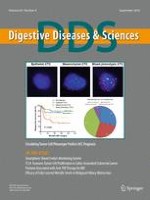Erschienen in:

07.05.2018 | Original Article
Circulating microRNA-22-3p Predicts the Malignant Progression of Precancerous Gastric Lesions from Intestinal Metaplasia to Early Adenocarcinoma
verfasst von:
Tsung-Hsing Chen, Cheng-Tang Chiu, Chieh Lee, Yin-Yi Chu, Hao-Tsai Cheng, Jun-Te Hsu, Ren-Chin Wu, Ta-Sen Yeh, Kwang-Huei Lin
Erschienen in:
Digestive Diseases and Sciences
|
Ausgabe 9/2018
Einloggen, um Zugang zu erhalten
Abstract
Background
Gastric cancer has a poor outcome and identifying useful biomarkers from peripheral blood or tissue could allow its early detection, or potentially precancerous changes, thus improving the curative rates. MicroRNAs (miRNAs) have been shown to offer great potential in cancer diagnosis and prediction.
Aim
Here, we investigated the role of plasma miRNAs in the natural course of gastric cancer, from intestinal metaplasia to early cancer. The findings were used to understand whether patients at a high risk of malignancy could be given appropriate interventions in the early disease process, such as using endoscopic submucosal dissection to treat gastric dysplasia or early gastric cancer.
Methods
Participants were divided into healthy control, intestinal metaplasia (IM), and dysplasia/early cancer (pT1a/b) groups. Microarray was used to select potential markers in tissue.
Results
Quantitative real-time polymerase chain reaction data showed circulating miRNA-22-3p had significantly different expression in patients with precancerous lesions or gastric adenocarcinoma. The areas under the curve of incomplete IM versus healthy control, low-grade/high-grade dysplasia, early gastric cancer, and GED were 0.8080, 0.8040, 0.8494, and 0.8095, respectively (all P values < 0.05).
Conclusions
Circulating miRNA-22-3p could be a potential biomarker for gastric precancerous dysplasia and early cancer detection.











